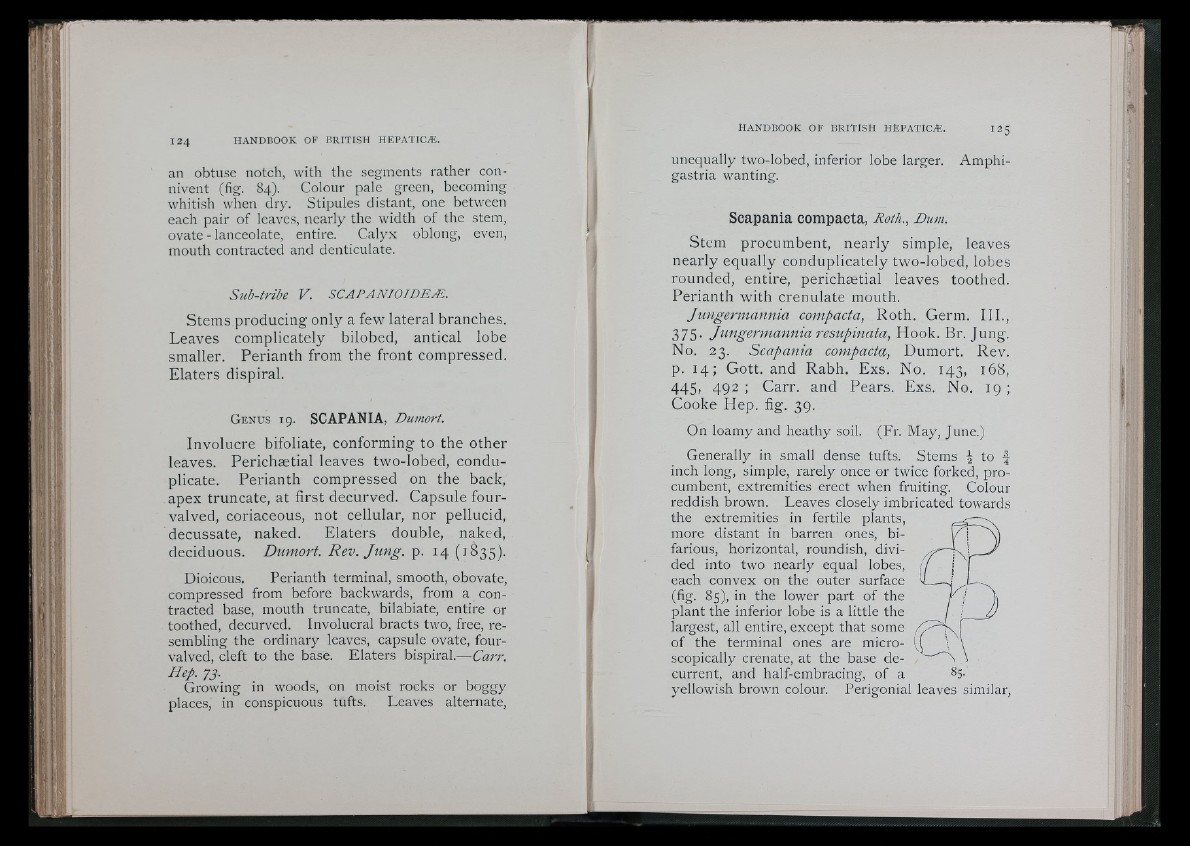
an obtuse notch, with the segments rather connivent
(fig. 84). Colour pale green, becoming
whitish when dry. Stipules distant, one between
each pair of leaves, nearly the width of the stem,
ovate - lanceolate, entire. Calyx oblong, even,
mouth contracted and denticulate.
Sub-tribe V. SCAPANIOIDEÆ.
Stems producing only a few lateral branches.
Lea v e s complicately bilobed, antical lobe
smaller. Per ianth from the front compressed.
Elaters dispiral.
G e n u s 19. SCAPANIA, Dumort.
Involucre bifoliate, conforming to the other
leaves. Perichaetial leaves two- lobed, conduplicate.
Per ianth compressed on the back,
apex truncate, at first decurved. Capsule four-
valved, coriaceous, not cellular, nor pellucid,
decussate, naked. Elater s double, naked,
deciduous. Dumort. Rev. Ju n g . p. 14 (1835).
Dioicous. Perianth terminal, smooth, obovate,
compressed from before backwards, from a contracted
base, mouth truncate, bilabiate, entire or
toothed, decurved. Involucral bracts two, free, resembling
the ordinary leaves, capsule ovate, four-
valved, cleft to the base. Elaters bispiral.— Carr.
Hep. 73. • , u
Growing in woods, on moist rocks or boggy
places, in conspicuous tufts. Leaves alternate.
unequally two-lobed, inferior lobe larger. Amphigastria
wanting.
Scapania compacta, Roth., Dum.
Stem procumbent, nea r ly simple, leaves
near ly equa lly conduplicately two-lobed, lobes
rounded, entire, per ichæt ial leaves toothed.
Perianth with crenulate mouth.
Jungermannia compacta, Roth. Germ. I lL ,
3 7 5 - Jungermannia resupinata. Hook. Br. Jung.
No. 23. Scapania compacta, Dumort. Rev.
p. 1 4 ; Got t . and Rabh. Exs. No. 143, 168,
445, 4 9 2 ; Carr, and Pears. Exs. No. 1 9 ;
Co o k e Hep. fig. 39.
On loamy and heathy soil. (Fr. May, June.)
Generally in small dense tufts. Stems 4 to |
inch long, simple, rarely once or twice forked, procumbent,
extremities erect when fruiting. Colour
reddish brown. Leaves closely imbricated towards
the extremities in fertile plants,
more distant in barren ones, bifarious,
horizontal, roundish, divided
into two nearly equal lobes,
each convex on the outer surface
(fig. 85), in the lower part of the
plant the inferior lobe is a little the
largest, all entire, except that some
of the terminal ones are microscopically
crenate, at the base decurrent,
and half-embracing, of a
yellowish brown colour. Perigonial leaves similar.